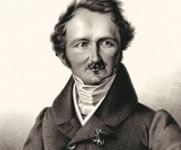Famous People
- Fairytale refuges for the fairytale king
- A paradise born of the Age of Enlightenment
- Fruits borne of strong women
- The “Sun King” of Saxony
- A romantic symbol of German history
- “My heart belongs to my garden”
- Royal life in modern times
- One masterpiece by two geniuses
- Monument to a passion for horticulture
- Count Bernadotte's flower island
- Preserving the cultural heritage
- Retreat for a king and philosopher
- A successful symphony of art and nature
- A Guelph family heirloom
A successful symphony of art and nature
Karl Friedrich Schinkel and Peter Joseph Lenné developed a remarkably congenial partnership, each complementing the other and both spurring each other on to develop a philosophical and aesthetic concept of beautification. They created a subtle but ingenious choreography of nature, art and architecture. Lenné, the son of a long-established family of gardeners from Bonn, worked for four different rulers over five decades. He transformed the landscape between Berlin and Potsdam into a magnificent area of parkland, improved Berlin's Tiergarten park and built the Landwehr canal. He died in Potsdam in 1866, aged 77 and highly acclaimed. He is buried in a plain grave in the city's Bornstedt cemetery. Karl Friedrich Schinkel was born in Neuruppin in 1781. He was an architect, painter and city planner, and was instrumental in the rise of neo-classicism in Prussia. His clarity of style adhered to the renouncement of the over-elaborate baroque as prescribed by the Prussian Enlightenment. His most famous buildings are located in and around Berlin. The enormous body of work he had built up before his death in 1841 went on to influence whole generations of architects until the arrival of Bauhaus.
Glienicke Palace & Park, Berlin-Zehlendorf
Show on map »
Travel Planner
Select an option...
Location
- Glienicke Palace & Park, Berlin-Zehlendorf



